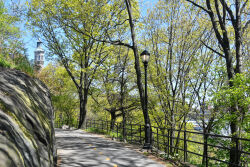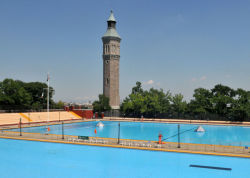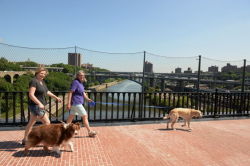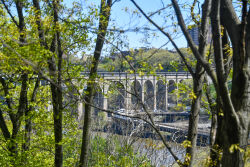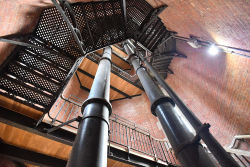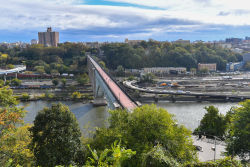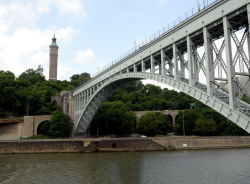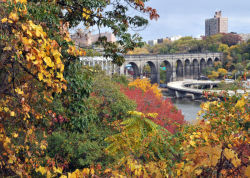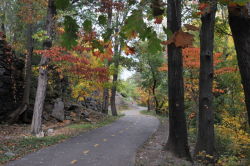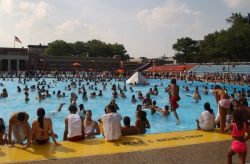Highbridge Park
The Daily Plant : Wednesday, January 16, 2013
High Bridge Restoration Underway
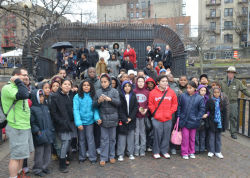
Photo by Daniel Avila
On Friday, January 11, Mayor Michael R. Bloomberg broke ground on the restoration of the High Bridge, one of the eight regional parks being transformed under PlaNYC, the City’s long-term plan for a greener, greater New York.
The $61 million rehabilitation of the High Bridge will reopen it for pedestrians and bicyclists, while providing a crucial link between Manhattan and the Bronx over the Harlem River. By 2014, the High Bridge will be rehabilitated and reopened for pedestrians and bicyclists, providing an essential link in New York City’s expanding waterfront Greenway. It will allow Bronx residents to reach the Highbridge Pool and Recreation Center, and Manhattan residents to reach the Harlem River waterfront.
The Mayor was joined at the groundbreaking by First Deputy Mayor Patricia E. Harris, Parks Commissioner Veronica M. White, Department of Design and Construction Commissioner David J. Burney, Department of Environmental Protection Carter Strickland, Congressman José E. Serrano, Councilman Ydanis Rodriguez, State Senator Adriano Espalliat, and Assemblywomen Gabriela Rosa and Vanessa Gibson. Also in attendance were students from P.S. 11 and P.S. 126. Speaking at the event was Joscelyn Fuentes, a 6th grade student, who has been a High Bridge Historian member for three years.
The High Bridge is the oldest remaining bridge in New York City. The bridge spans the Harlem River, connecting the neighborhoods of Highbridge in the Bronx and Washington Heights in Manhattan. First opened in 1848 as part of the Old Croton Aqueduct, the 1,200–foot–long, 116-foot-tall High Bridge walkway first brought fresh water to New York City from Westchester County and fueled the city’s northward expansion. It was closed to regular public use around 1970. Planned improvements will make the bridge more accessible and safe. The rehabilitation will follow historic preservation principles to restore the architectural details of this landmarked structure for public enjoyment. The project received about $50 million in funding from Mayor Bloomberg’s PlaNYC initiative. Additional allocations of about $5 million from Congressman José E. Serrano and $7 million in federal transportation grants were critical to move the more than $61 million project forward.
The High Bridge is actually two adjoining spans: one of structural steel, and another of masonry. Both will be cleaned and repaired; the steel span will be repainted and the masonry structure will be repointed and strengthened. Architectural lighting will be installed beneath both spans. The brick paver walkway on top of the structure will be removed and reconditioned, new waterproofing and concrete will be installed, then the historic brickwork will be reinstalled. The aqueduct running beneath the structure will be repaired and stabilized. New lampposts and safety fencing will be installed and the original iron railing will be repaired. Barrier-free access ramps will be built on both sides of the bridge to allow access for the disabled. Three viewing platforms with bench seating will be installed along the length of the bridge.
The High Bridge was chosen as part of the Catalyst for Neighborhood Parks initiative, a public-private partnership combining City-funded capital improvements with the City Parks Foundation’s privately funded arts, sports, education and community-building programs. The Catalyst for Neighborhood Parks initiative is managed through Partnerships for Parks, a joint program of the NYC Parks Department and City Parks Foundation (CPF). From 2004 – 2008, Partnerships for Parks tracked an increase in user-ship at Highbridge Park by 161 percent and an increase in involved members of the community by 89 percent, due to CPF’s outreach, organizing & programming efforts. The High Bridge Coalition, a park advocacy coalition of 52 neighborhood organizations, was created by CPF, and Partnerships and the coalition administered more than 500 PlaNYC surveys to the community to help inform the restoration design and ensure community participation. Through these efforts, free SummerStage concerts and children's programs were brought to the park to engage the surrounding community, and the coalition worked closely with Congressman Serrano to leverage and secure capital funds to restore the bridge.
Other regional parks already developed as part of PlaNYC include McCarren Pool and the first phase of Calvert Vaux Park in Brooklyn; and Rockaway Park in Queens. Regional parks currently in construction as part of PlaNYC include Fort Washington Park in Manhattan; Soundview Park in the Bronx, the Ocean Breeze Indoor Track and Field Facility on Staten Island; and Highland Park in Queens. Also, thus far as part of PlaNYC, 227 Schoolyard to Playground sites were opened to the public, 26 asphalt yards were converted to turf fields, lights were installed at 16 fields to allow for extended playing hours, 319 Greenstreets were planted, and more than 643,000 trees were planted under MillionTreesNYC.
“All things are difficult before they are easy.”
Dr. Thomas Fuller
(1654 - 1734)
Check out your park's Vital Signs
Clean & Safe
Green & Resilient
Empowered & Engaged Users
Share your feedback or learn more about how this park is part of a
Vital Park System

